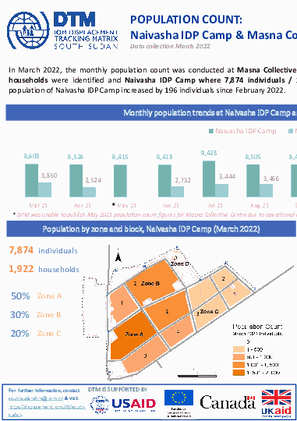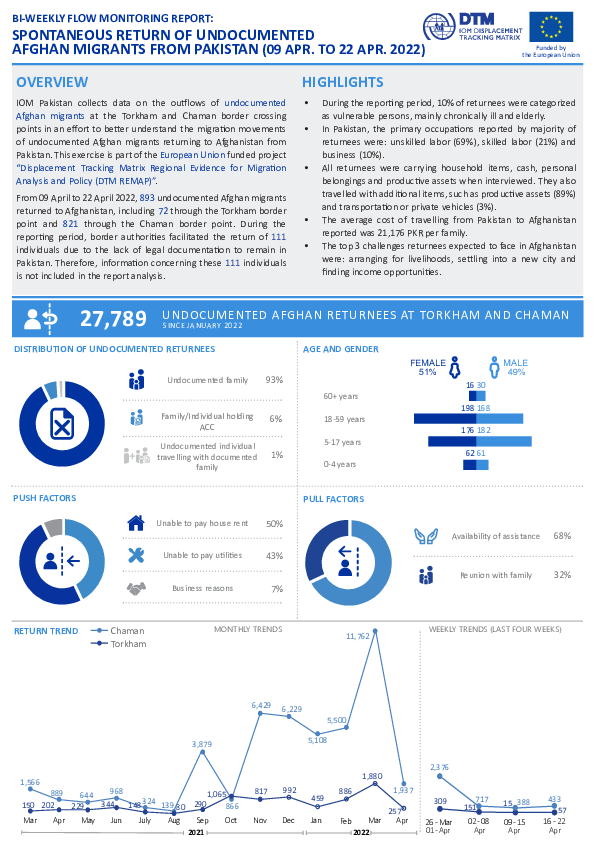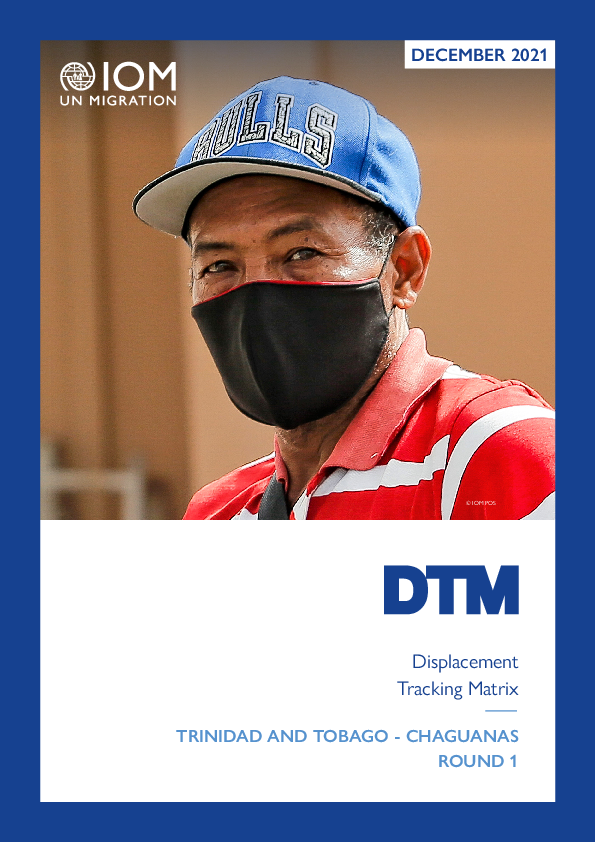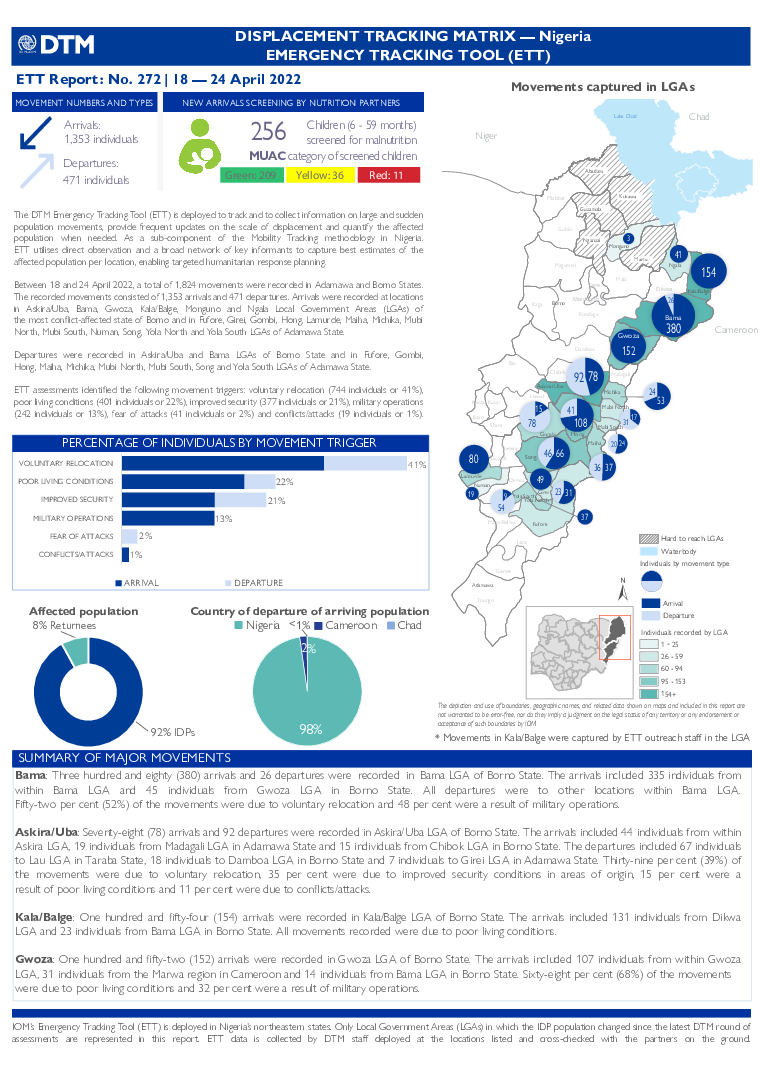-
Countries
-
Data and Analysis
-
Special Focus
-
Crisis Responses

Contact
DTM South Sudan, SouthSudanDTM@iom.int
Language
English
Location
South Sudan
Period Covered
Mar 01 2022
Mar 31 2022
Activity
- Registration
- Flow Monitoring
- Mobility Tracking
- Site Assessment
In March 2022, the monthly population count was conducted at Masna Collective Centre where 3,053 individuals/ 726 households were identified and Naivasha IDP Camp where 7,874 individuals / 1,922 households were counted. The population of Naivasha IDP Camp increased by 196 individuals since February 2022.

Contact
iomisbdtmremapteam@iom.int
Language
English
Location
Pakistan
Period Covered
Jan 01 2022
Mar 31 2022
Activity
- Flow Monitoring
IOM Pakistan collects data on the outflows of undocumented Afghan migrants at the Torkham and Chaman border crossing points in an effort to better understand the migration movements of undocumented Afghan migrants returning to Afghanistan from Pakistan. This report is part of the European Union funded project ‘‘Displacement Tracking Matrix Regional Evidence for Migration Analysis and Policy (DTM REMAP)”. Key findings during this reporting period are:
- From January to March 2022, 25,595 undocumented Afghan migrants spontaneously returned to Afghanistan, including 3,225 through the Torkham border point and 22,370 through the Chaman border point.
- Among the total number of undocumented Afghan returnees, border authorities facilitated the return of 538 individuals due to the lack of legal documentation to remain in Pakistan. Therefore, information concerning these 538 individuals is not included in the report analysis.
- The average family size of returnees was 10 individuals and 13% of all returnees recorded during the reporting period were categorized as vulnerable persons.
- All returnees were carrying household items, personal belongings and cash when surveyed. They also traveled with additional items, such as productive assets (97%) and transportation vehicles (7%).
- The top 3 challenges returnees expected to face in Afghanistan were: arranging livelihood, settling into a new city and finding better income opportunities.

Contact
iomisbdtmremapteam@iom.int
Language
English
Location
Pakistan
Period Covered
Apr 09 2022
Apr 22 2022
Activity
- Flow Monitoring
IOM Pakistan collects data on the outflows of undocumented Afghan migrants at the Torkham and Chaman border crossing points in an effort to better understand the migration movements of undocumented Afghan migrants returning to Afghanistan from Pakistan. This exercise is part of the European Union funded project “Displacement Tracking Matrix Regional Evidence for Migration Analysis and Policy (DTM REMAP)”. From 09 April to 22 April 2022, 893 undocumented Afghan migrants returned to Afghanistan, including 72 through the Torkham border point and 821 through the Chaman border point. During the reporting period, border authorities facilitated the return of 111 individuals due to the lack of legal documentation to remain in Pakistan. Therefore, information concerning these 111 individuals is not included in the report analysis.

Contact
DTM Mozambique, DTMMozambique@iom.int
Language
English
Location
Mozambique
Period Covered
Jan 10 2022
Feb 15 2022
Activity
- Mobility Tracking
- Site Assessment
This Multi-Sectorial Location Assessment (MSLA) report, which presents findings from the International Organization for Migration’s (IOM) Displacement Tracking Matrix (DTM) Round 8 assessments, aims to enhance understanding of the extent of internal displacements and the needs of affected populations in conflict-affected districts of Northern Mozambique. Data was collected between 10 January and 15 February 2022 in close coordination with provincial government and Instituto Nacional de Gestão e Redução do Risco de Desastres (INGD) partners, and presents trends from 66 assessed sites hosting internally displaced persons across nine districts in Cabo Delgado, 3 sites in Niassa, and 2 site in Nampula.
In total, 216,413 internally displaced persons (IDPs) (an increase of 1% since the previous round) or 53,819 households were mapped living in sites assessed during this MSLA. Reported fi gures, however, exclude displaced individuals living in host community settings. According to DTM Round 15 Baseline, as of February 2022, an estimated 702,735 IDPs were identified living in both host communities and sites in Cabo Delgado, 76,568 IDPs in Nampula, and 3,552 IDPs in Niassa.
This Round 10 of the COVID-19 Situation Analysis is based on the assessment of knowledge, practice and impact of the pandemic on internally displaced persons (IDPs) in conflict-affected communities of north-east Nigeria. Conducted by the Displacement Tracking Matrix (DTM) unit of the International Organization for Migration (IOM), the report covers the period between 14 February and 30 March 2022 and reflects trends from the states Adamawa, Bauchi, Borno, Gombe,
Taraba and Yobe in north-east Nigeria.
The assessment was conducted in 2,365 locations – a decrease compared to the 2,371 sites assessed in the 9th round of assessment. These sites included 290 camps and camp-like settings and 2,075 locations where IDPs were residing with host communities. As expected, the most-affected state of Borno had the highest number of assessed locations with 688 sites (29%). These included both camps and camp-like settings as well as host communities. Taraba had the least number of locations assessed with 202 sites (9%). As in other similar assessments, staff from IOM, NEMA, SEMAs and the Nigerian Red Cross Society collated the data in the field, including baseline information at Local Government Area and ward-levels.

Contact
DTM Nigeria, AllUsersInDTMNigeria@iom.int
Language
English
Location
Nigeria
Period Covered
Apr 18 2022
Apr 24 2022
Activity
- Mobility Tracking
- Event Tracking
Nigeria's north-central and north-west zones are afflicted with a multidimensional crisis rooted in long-standing tensions between ethnic and religious groups and involves attacks by criminal groups and banditry/hirabah (such as kidnapping and grand larceny along major highways). During the past years, the crisis has accelerated because of the intensification of attacks and has resulted in widespread displacement across the region.
Between the 18th and 24th of April 2022, armed clashes and banditry have led to new waves of population displacement. Following these events, rapid assessments were conducted by DTM (Displacement Tracking Matrix) field staff to inform the humanitarian community and government partners, and enable targeted response. Flash reports utilise direct observation and a broad network of key informants to gather representative data and collect information on the number, profile and immediate needs of affected populations.
During the assessment period, the DTM identified an estimated 3,222 individuals who were affected by the attacks. A total of 3,190 individuals were displaced to neighbouring wards in the LGAs Guma and Gwer West in Benue State, Kware in Sokoto State and Gusau in Zamfara State. A total of 72 casualties were reported, including 40 injuries and 32 fatalities.

Contact
DTM Nigeria, AllUsersInDTMNigeria@iom.int
Language
English
Location
Nigeria
Period Covered
Apr 16 2022
Apr 22 2022
Activity
- Mobility Tracking
- Baseline Assessment
- Points of Entry (PoE)
During the COVID-19 pandemic, IOM's Displacement Tracking Matrix (DTM), in collaboration with the World Health Organization (WHO), monitors cross-border movements to and from Nigeria's Borno State in north-east Nigeria. Assessments are conducted at Points of Entry located along the border with Cameroon.
A range of data was collected during the assessments to better inform on travellers’ nationalities, sex, reasons for moving, mode of transportation and timeline of movement as shown in figures 2 to 5 below:
Contact
DTM Mozambique, DTMMozambique@iom.int
Location
Mozambique
Activity
- Mobility Tracking
- Site Assessment
Period Covered
Jan 10 2022 -Feb 15 2022
A site assessment is a sub-component of mobility tracking. It aims to collect data on population presence, living conditions and needs in a particular displacement site or community.
Population Groups
Survey Methodology
Unit of Analysis Or Observation
Type of Survey or Assessment
Keywords
Geographical Scope
Administrative boundaries with available data
The current dataset covers the following administrative boundaries

Contact
jali@iom.int
Language
English
Location
Trinidad & Tobago
Period Covered
Dec 01 2021
Dec 31 2021
Activity
- Survey
- Flow Monitoring Survey
The Borough of Chaguanas is the largest municipality and fastest-growing town in Trinidad and Tobago. It is situated on the western coast of Trinidad, upstream from the Caroni Swamp, between the two main cities of Port of Spain and San Fernando.1 Chaguanas spans 59km², with a population of 83,516 persons.2 It comprises several communities and sub-areas, which encompass vast areas of agricultural land. Moreover, this region’s human development index, in 2012, was 0.686 and 62.9% of its population had obtained secondary and higher education.3 Accordingly, given the trend of escalating inflows of Venezuelan nationals into Trinidad and Tobago,4 Chaguanas has featured in Displacement Tracking Matrix (DTM) 2021 as having the second highest number of Venezuelan migrant respondents in the exercise. Furthermore, in the wake of the Covid-19 pandemic, heightened health and safety protocols to combat the spread of the virus, have inadvertently exacerbated economic issues and migrant vulnerabilities. Notwithstanding this, in March 2021, the Government of Trinidad and Tobago (GORTT) conducted a re-registration exercise for Venezuelans, who were previously registered under the Venezuelan Migrant Registration Framework in June 2019, to extend their regular status and options for legitimate employment. In addition, with the assistance of the Venezuelan Embassy, there was a major voluntary repatriation exercise of 680 Venezuelan nationals, in July 2021. Apart from this, COVID-19 vaccines have been made available to Venezuelan migrants in Trinidad and Tobago. The DTM 2021, Sub-report for the Borough of Chaguanas, therefore presented an excellent opportunity to examine the situation of Venezuelan migrants against these backgrounds, and within the framework of the Fostering local communities of solidarity for migrants and refugees project, which is funded under the Development Cooperation Instrument (DEVCO). IOM’s DTM is a system to track and monitor displacement and population mobility. It is designed to capture, process, and disseminate critical multi-layered information on the mobility, vulnerabilities, and needs of displaced and mobile populations, regularly and systematically. Hence, the DTM provides decision-makers and responders with insightful data to guide specific assistance to target populations. A total of 188 Venezuelan migrants from the Borough of Chaguanas participated in DTM 2021 between October and November 2021. The areas with the highest number of respondents were Cunupia, followed by Longdenville, and Chaguanas Proper, as shown in Map 1. It must be noted, however, that 18 respondents indicated that they did not know in which community they resided.

Contact
DTM Nigeria, AllUsersInDTMNigeria@iom.int
Language
English
Location
Nigeria
Period Covered
Apr 18 2022
Apr 24 2022
Activity
- Mobility Tracking
- Event Tracking
The DTM Emergency Tracking Tool (ETT) is deployed to track and to collect information on large and sudden population movements, provide frequent updates on the scale of displacement and quantify the affected population when needed. As a sub-component of the Mobility Tracking methodology in Nigeria.
ETT utilises direct observation and a broad network of key informants to capture best estimates of the affected population per location, enabling targeted humanitarian response planning.
Between 18 and 24 April 2022, a total of 1,824 movements were recorded in Adamawa and Borno States. The recorded movements consisted of 1,353 arrivals and 471 departures. Arrivals were recorded at locations in Askira/Uba, Bama, Gwoza, Kala/Balge, Monguno and Ngala Local Government Areas (LGAs) of the most conflict-affected state of Borno and in Fufore, Girei, Gombi, Hong, Lamurde, Maiha, Michika, Mubi North, Mubi South, Numan, Song, Yola North and Yola South LGAs of Adamawa State.
Departures were recorded in Askira/Uba and Bama LGAs of Borno State and in Fufore, Gombi, Hong, Maiha, Michika, Mubi North, Mubi South, Song and Yola South LGAs of Adamawa State.
ETT assessments identified the following movement triggers: voluntary relocation (744 individuals or 41%), poor living conditions (401 individuals or 22%), improved security (377 individuals or 21%), military operations (242 individuals or 13%), fear of attacks (41 individuals or 2%) and conflicts/attacks (19 individuals or 1%).

